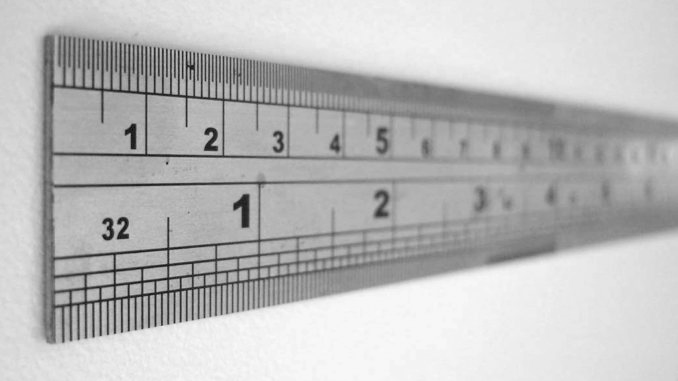steel_ruler_closeup
Gateposters argue over Metric System in Op/Ed pages: Debate spans three issues
Measurement Madness
By: Evan Lee, Staff Writer
Originally published in The Gatepost
April 12, 2019 | Argument 1

I recently made the mistake of buying a cheap new bicycle off eBay.
When it arrived, the box’s “this side up” arrow did not point up, an axle had pierced through its side, and the only protection found within was some paper to prevent scratching.
It was scratched anyway.
But undeterred by the scratches, dents, and buyer’s remorse, I set about putting my new bike together.
A task which didn’t seem like it’d be too much of a challenge at the time – just a few nuts and bolts to tighten, right?
Wrong.
The bike, having been made outside the U.S., was manufactured to metric standards – unsurprising since most other countries use the Metric System, but problematic here as we still rely on the Imperial System.
And evidently, metric hex sockets don’t get along with imperial Allen wrenches.
While the difference is just slightly off in their measurements, it’s enough to keep my bicycle in pieces while I write this article. A rather pathetic tragedy, I guess, but one that when expanded over a global scale, leaves more than enough room for actual catastrophes to happen.
Case in point: the infamous Mars Climate Orbiter incident of 1999.
When NASA launched its orbiter in December ’98 to embark on a $327.6 million mission, it’s unlikely that anyone expected a measly metric miscalculation to lead them to complete loss less than a year later.
But, according to Arthur Stephenson of the Mars Climate Orbiter Mission Failure Investigation Board, that’s exactly what happened.
“The root cause of the loss of the spacecraft was the failed translation of [imperial] units into metric units in a segment of ground-based, navigation-related mission software,” he said in a report.
Essentially, two separate mission teams were working with two different systems of measurement. Which is perfectly fine, until they have to share information with one another.
And apparently, when those two teams did go to share their information, they failed to convert the units they originally used, the investigation board found.
It’s a dilemma that anyone who has taken science classes may have encountered during exams.
If the conversion is done improperly in part A, then any attempts at doing parts B or C will be misguided since the information gathered to do so is wrong.
And screwing up on the test because of that is frustrating – I know from experience – but imagine how it must feel to do the same thing on a $327.6 million mission.
Probably not good.
Inevitably, the measurement error led to mission failure as the orbiter either drifted off into space or crashed somewhere it wasn’t supposed to on Mars.
An expensive mistake to say the least, but one that NASA didn’t blame on the different units involved – rather, NASA’s leadership blamed it on themselves.
“The problem here was not the error, it was the failure of NASA’s systems engineering, and the checks and balances in our processes to detect the error. That’s why we lost the spacecraft,” according to NASA’s Associate Administrator for Space Science at the time, Edward Weiler.
While it’s certainly true that NASA had failed to catch that error, is it really fair not to place any blame on the difference in measurement systems?
To put it bluntly, had only one system been used, then there would have never been any risk for such an error to have occurred in the first place.
And though NASA has improved its error detection methods since 1999, so long as the Metric and Imperial systems of measurement continue their attempt to co-exist here in the U.S., the risk of another error slipping through still remains – both for NASA and suckers who buy bikes off eBay.
The Whole 8.23 Meters
By: Gordan Rupert, Editorial Staff
Originally published in The Gatepost
April 26, 2019 | Argument 2

Recently, an op/ed was published by my colleague at The Gatepost highlighting the perceived folly of using both the Metric and Imperial Systems, and the problems when using them together.
In the article, the writer points to his personal experiences purchasing a foreign bicycle that had metric-sized parts incompatible with Imperial, or United States Customary System (USCS), sized wrenches, and the 1999 failure of the Mars Climate Orbiter, in which a miscalculation due to the use of both units resulted in the loss of the satellite.
While these may be good arguments for moving toward one global system, the most important aspects of life have already transitioned to one system – the Metric one.
Switching every miniscule aspect of life away from one system to the other would result in a loss of the culture unique and identifiable to the United States.
First, let’s look at the current reality of measurement systems used in professional areas.
We can see the usage of the Metric System in every STEM field and job. I wonder if there is even an official STEM textbook in the United States that doesn’t use the Metric System for anything beyond the fundamentals.
Likewise, any international industry can’t use the Imperial System without risking mistranslations that could cost millions of dollars to fix.
Further, the federal government itself passed the Metric Conversion Act of 1975, which stated that the Metric System was “the preferred system of weights and measures for U.S. trade and commerce,” called on the movement to the Metric System by companies, and even stated that the government had to help with the voluntary change.
So, with the government offering to help create the change, why, over 40 years later, do we still use two systems of measurement?
Let’s ask another question – which would you rather eat, a quarter-pounder, or a 113.4-gram hamburger?
The USCS is a system engrained not in American eagerness to reject something foreign, but in hundreds of years of cultural and social identification through measurements both easy to express and easy to remember.
Cup of Joe. Footlong hotdog. Ton of bricks – easy to understand, easy to imagine, and unable to be translated into Metric.
These are the shorthands and standards of American culture.
Of my culture.
Every concession has been made where it needs to be in the professional world. Beyond that, the USCS has been designed for human use over hundreds of years.
A cup of Joe is about 8 ounces. A footlong hotdog is at least as big as my foot. A ton of bricks is too many for me to count, but I know it’s an awful lot, and it hurts when it falls on you.
Is moving to one measurement system an attack on who I am? No, that’s ridiculous. It’s an argument that has existed for hundreds of years before the Metric System.
But, the ideological ham-fisting of the Metric System into everyday life, through a call for a single, universal system, is something I can’t support.
For all my life, and my parents’ lives, and my grandparents’ lives, every measurement we’ve used has been good enough for us. Our system isn’t worried about putting people on Mars, and we know that.
But we also know how many cups of Joe we need in the morning. We know how full we feel after a footlong hotdog. And we will be damn sure dissatisfied if the Metric System hits us like a ton of bricks.
A Cup of Culture
By: Evan Lee, Staff Writer
Originally published in The Gatepost
May 3, 2019 | Argument 3

A bicycle, a cup of Joe, and this royalty free image of “steel_ruler_closeup” have all come to define an epic debate of immeasurable wit – and lousy gags – between a colleague and me over … systems of measurement.
We’re both the life of the party.
It all began after I wrote an article on my experiences in trying, and failing, to build a Metric-made foreign bicycle with Imperial measured American tools.
A case of “Measurement madness,” as I called it.
But not allowing this tragedy to go in vain, I decided to draw upon it – along with a more important mix-up by NASA in 1999 – to argue that only chaos and confusion prevails when Metric and Imperial collide.
And thus, it is no longer feasible for them to coexist within the U.S.
Yet, my colleague has gone “The whole 8.23 meters” to disagree.
He countered in his own article that not only is it unnecessary to move to one system, it would be unwise as the consequences of doing so are culturally catastrophic.
He raised to my article a cup of Joe before dropping a ton of bricks over it. Those being just a few of “the shorthands and standards of American culture” that would be lost to the mediocrity of Metric – the global system likeliest to dethrone Imperial.
And that’s an argument I can sympathize with.
Because I like the Imperial System. It’s worked for me, it’s worked for my colleague, and it’s worked for generations before us – as he pointed out in his article. Not to mention it’s what every tool I’ve owned was once measured by.
But I have to emphasize once now – because I finally built my bike.
It cost me an extra $12 to get the metric tools I needed – on top of something I already paid too much for – but it marked my preparation for the future.
And the future is in Metric.
But why? Why bother changing to Metric when I’ve just conceded that Imperial still works?
Well, why change to the automobile when horse drawn carriages still work?
Truly, the covered wagon is an American cultural icon. For generations, they took us across the entire continental U.S. while leaving cultural legacies along each rut of every trail they made.
And, as the Amish would contend, they still work just as well today.
Yet by the turn of the 20th century, Americans had begun to abandon the traditional ways of their wagons for a newer system – the horseless carriage.
And while these two systems of transportation did share the roads at first, it inevitably became apparent that such harmony couldn’t last.
Imagine trying to merge a wagon onto Route 9 – it’d just be a disaster waiting to happen.
A disaster not unlike the madness of Metric merging with Imperial.
I lost an extra $12 last week because of that mix-up, NASA lost $327.6 million in 1999, and somebody else is probably losing out right now.
When does the systemically driven madness end?
Well, for systems of transportation, it ended midway through the 20th century as the horse drawn carriage culture of America’s past was all but overtaken by the current car culture of today.
The Oregon Trail, despite its countless crossings and cultural significance, was succeeded by Route 66 – now a cultural icon in of itself.
And perhaps this foreshadows the end to shared systems of measurement in the 21st century, as the newer Metric System increasingly shows up in our everyday lives.
And not just for big businesses and organizations, but for common Americans who might make the mistake of buying a bike off the internet without checking what system it’s measured by first.
Just as Route 66 came to have the nickname of “America’s mother road,” perhaps Metric will come to be known as America’s measurement system.
❱ Read this debate through The Gatepost’s print editions via Issuu »
Unfortunately, Internet Archive never scraped them while they were online.



